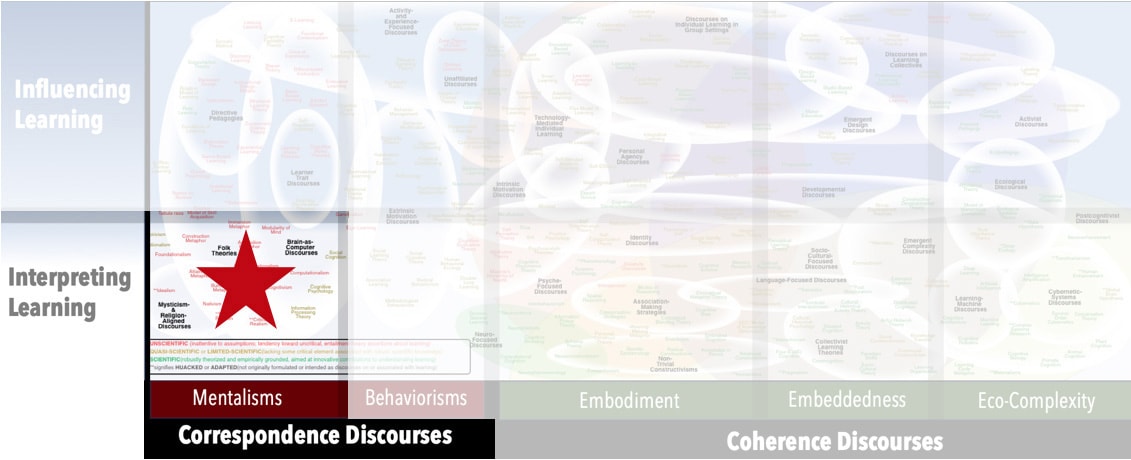Focus
Interpreting learning in terms of shining a light on darknessPrincipal Metaphors
- Knowledge is … enlightenment; all that has been illuminated
- Knowing is … seeing
- Learner is … a see-er (individual)
- Learning is … coming to see (pulling into the light; overcoming darkness)
- Teaching is … showing; highlighting; shining a light on
Originated
Ancient (entrenched in the language)Synopsis
The Illumination Metaphor frames knowledge and learning in terms of visibility and clarity. Perhaps most commonly encountered in phrases such as “I see” – meaning, “I understand” – the Illumination Metaphor tends to be coupled with either the Acquisition Metaphor’s version of knowledge (i.e., there’s an object to be seen) or the Nativism’s version of knowledge (i.e., there’s an inner truth to be pulled into the light). The notion has been the focus of critique for some time:- Spectator Theory of Knowledge (John Dewey, 1890s) – a phrase offered as a critique of the Illumination Metaphor and its associated assumptions of knower-independent, object-like truths
- Intuition Metaphor – derived from the Latin in- “at, on” + tueri “to look at, watch over”
- Reflection Metaphor (various, 1600s) – a thought about a thought – that is, metaphorically, observing an observation
- Theory Metaphor – derived from the ancient Greek from theōrein “to look at”
- Think Metaphor – derived from the Old English þencan “cause to appear to oneself”
Commentary
The Illumination Metaphor – that is, the notion of “knowing as seeing” – is present in all Indo-European languages, which means that it may have originated in a shared proto-language and that it is one of the more difficult notions to isolate and critique. Phrased quite differently, the Illumination Metaphor rests on and supports many of the uncritical and indefensible assumptions about learning that are associated with most Folk Theories – such as, for example, separations of inside from outside and mental from physical. The notion may be bolstered by the fact that vision takes up more brain resources that any of the other senses, a detail that some have used to argue that vision is the dominant sense. (Hearing and touch are the only other senses that are used as metaphors for understanding, but they are much more rarely encountered … and are typically associated with a strong emotional component, hinted in “I hear that” and “I feel you.”) A more fundamental failing of the metaphor is an associated need for an "inner eye" or a homunculus (Latin for "little person") to view the whatever is internally illuminated.Authors and/or Prominent Influences
As with many other Folk Theories, it is impossible to date the Illumination Metaphor. It is prominent in the Bible and in ancient Greek texts, so it dates back at least millennia.Status as a Theory of Learning
The Illumination Metaphor is included among Folk Theories.Status as a Theory of Teaching
While not a theory of teaching, interpreting pedagogy is widely interpreted as illuminating, making things clear, shining a light on, highlighting, and so on. It is difficult to specify the nature and extent of the Illumination Metaphor’s influence on teaching practice in general, but it is especially evident in expectations for clarity (in explanations, expectations, evaluations, etc.).Status as a Scientific Theory
The Illumination Metaphor meets none of our criteria for a scientific theory.Subdiscourses:
-
Intuition Metaphor -
Intuition Metaphor – derived from the Latin in- “at, on” + tueri “to look at, watch over”
-
Reflection Metaphor -
Reflection Metaphor (various, 1600s) – a thought about a thought – that is, metaphorically, observing an observation
-
Spectator Theory of Knowledge -
Spectator Theory of Knowledge (John Dewey, 1890s) – a phrase offered as a critique of the Illumination Metaphor and its associated assumptions of knower-independent, object-like truths
-
Theory Metaphor -
Theory Metaphor – derived from the ancient Greek from theōrein “to look at”
- Think Metaphor - Think Metaphor – derived from the Old English þencan “cause to appear to oneself”
Map Location

Please cite this article as:
Davis, B., & Francis, K. (2023). “Illumination Metaphor” in Discourses on Learning in Education. https://learningdiscourses.com.
⇦ Back to Map
⇦ Back to List
